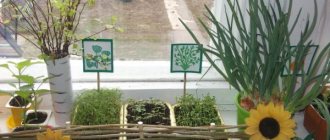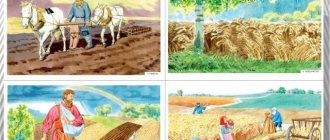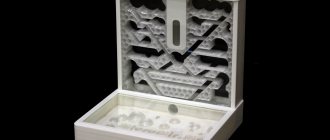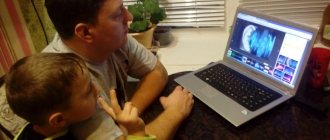Research project “Mysterious Space” in the middle group of a preschool educational institution
- April 15, 2016
Competition “Methodological piggy bank of a teacher - 2016”
Nomination “Methodological piggy bank of a preschool teacher”
Creative report on research activities in the middle group of a preschool educational institution. Topic: Mysterious space.
Project participants: children of the middle group of kindergarten No. 24 “Swallow”, a team of teaching staff, an initiative group of parents of pupils, kindergarten specialists.
Type of project: creative information and research.
Duration: short duration - from March to April.
Relevance of the project. After watching the animated film “Dunno on the Moon,” the children in my group began asking questions that were difficult to answer in a way that the kids could easily understand. And each new answer gave rise to new questions. As a result, we have reached a dead end. But after thinking and consulting, we came to a common opinion - we are preparing a new information and research project “Mysterious Space”.
Project goal: To promote the development of search activity and develop cognitive activity. Teach children how to independently find the necessary information on a given topic. Expand your horizons, vocabulary, creativity.
Personality-oriented tasks:
- develop research skills: ask questions, collect necessary information together with adults from various sources (fiction, looking at the starry sky through a telescope, conversations with teachers and parents, watching thematic videos);
- teach correctly, formulate conclusions and conclusions;
- present your research in the form of a knowledge product (drawings, applications, drawing up power lines, collage, wall newspaper design, photo report, presentation, etc.).
Educational objectives:
- help children learn about the world around them;
- teach how to obtain information from different sources;
- develop the ability to predict certain actions;
- encourage the desire to learn new and unknown things.
Educational tasks:
- cultivate goodwill and activity in the learning process;
- contribute to the creation of an active research position for both children and their parents.
Expected results:
- acquisition of research skills;
- collected necessary information on the topic being studied;
- children's knowledge of space.
Received smart products:
- consultation for parents “Should I talk to my child about space?”;
- development of didactic games: “Help the rocket return to earth”, “Help the astronaut find his rocket”, “Find the extra object”.
- compiling a power transmission manual book “Secrets of Space” to consolidate acquired knowledge;
- exhibition of drawings and applications about space;
- design of a wall newspaper;
- photo report and presentation.
Project stages
I. Preparatory stage. The content of the work:
- choosing a topic, identifying a problem;
- defining the goals and objectives of the project.
- discussing the project with the children and their parents, choosing sources of information;
- drawing up a work plan for the project;
- development of homework for all project participants.
Expected result:
- acquiring knowledge on the topic being studied;
- accumulation of information base (sources of received information);
- availability of a clear work plan for all researchers;
- availability of survey results.
II. Practical stage. The content of the work:
- studying sources on research questions;
- collection and systematization of material;
- carrying out various educational, creative, scientific forms of work with children during the implementation of the project;
- interaction between all project participants (conversation, consultation, information stand);
- consultations and practical assistance in the production of creative project products;
- compilation and design of creative reports.
Expected result:
- coordinated work of all project participants;
- exhibition of children's creative works;
- organized cognitive, playful, research and creative activities of children in a group, on the street and at home;
- creation of didactic games, beech power lines, photo report, selection of pictures on the topic, preparation of presentation.
III. The final stage. The content of the work:
- reflection-analysis of the project implementation, achieved results;
- preparation for project defense (broadcast);
- multimedia presentation of the project.
Expected result:
- availability of methodological materials and project products;
- high level of children's knowledge and skills.
Project progress
I. Preparatory stage.
1. Setting goals and objectives for project participants.
2. Selection of information and recommendations for the parent corner on the research topic:
- consultation “Should I talk to my child about space?”
- recommendations for parents on how to conduct conversations with their children about space;
- distribution of tasks among project participants.
3. Selection of materials for acquaintance with space: photos, video presentations; poems, songs, riddles, cartoons, works of art, illustrations, etc. 4. Development of didactic games “Help the rocket return to earth”, “Help the astronaut find his rocket”, “Find the extra object”. 5. Conducting classes with children on making drawings, applications, beech power lines and wall newspapers.
II. Practical stage. Forms of work:
1. GCD. Complex thematic lesson: “What is space?” Goal: To introduce children to new concepts, such as: space, space station, spacesuit, satellite, cosmodrome, docking, etc. Encourage children's desire to learn new information about space. Create positive emotions. Develop creativity. Teach children to independently construct a rocket out of paper and place it on the paper to create a composition of the starry sky. Arouse positive emotions while listening to a piece of music performed by the ensemble “Fidgets” (song “We are the children of the galaxy”)
2. Thematic conversations on the research question: “What is space made of”, “The first cosmonaut - Yuri Gagarin”, “What do astronauts eat?” Compilation of the “Cosmic Dictionary”. During conversations, arouse persistent cognitive interest in research activities. Expand your horizons, encourage curiosity and inquisitiveness. Expand your vocabulary - learn correctly, ask questions and give complete answers to them. Encourage initiative.
3. Didactic games: “Help the rocket return to earth”, “Find the extra object”, “Help the astronaut find his rocket”.
4. Role-playing game “Flight to the Moon.”
5. Examination of photographs and illustrations about space and astronauts.
6. Listening to music about space, asking and guessing space-themed riddles.
7. Reading fiction (poems by A. Khait “Planets in Order” and V. Stepanov “Yuri Gagarin”).
8. Joint child-parent creativity. Study:
- "We and space." Objective: to form an idea of the location of people in outer space.
- "Space Explorers". Objective: To introduce children to the history of space exploration and exploration.
Work with parents: Joint work of parents and child at home (at the choice of the participants). The child independently reports on the work done.
Package No. 1 “Visit to the observatory” (excursion). Goal: To encourage children and their parents to actively engage in research activities, obtain information in new ways, and teach how to formalize personal experience.
Package No. 2 “Space Fantasies” (composing a story about the conquest of cosmic depths, with the characters of the animated film, Belka and Strelka). Goal: To teach children to fantasize by independently writing funny and instructive stories, followed by design and compilation of a baby book.
Package No. 3 “Space Games”. Goal: To attract the attention of parents to the joint activities of parents and children in the process of home education. Involve parents in the creation of a gaming base, supplement the corner of didactic games.
III. The final stage.
1. Design of children's creative works for the wall newspaper “April 12. Cosmonautics Day." 2. Thematic entertainment “Journey into Space” dedicated to the celebration of “Cosmonautics Day”. 3. Awarding the project participants with certificates and medals. 4. Evaluation of the work results of all project participants. 5. Presentation of the photo report “Amazing Space”.
Author: Victoria Pavlovna Sigitova, teacher of pre-school educational institution kindergarten No. 24 “Swallow”, Vladivostok.







